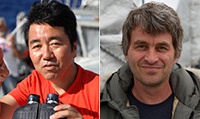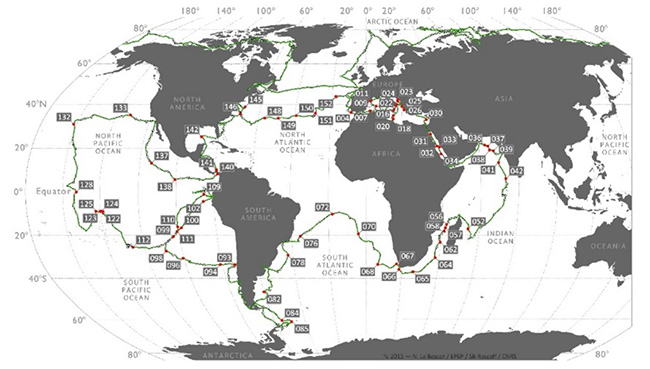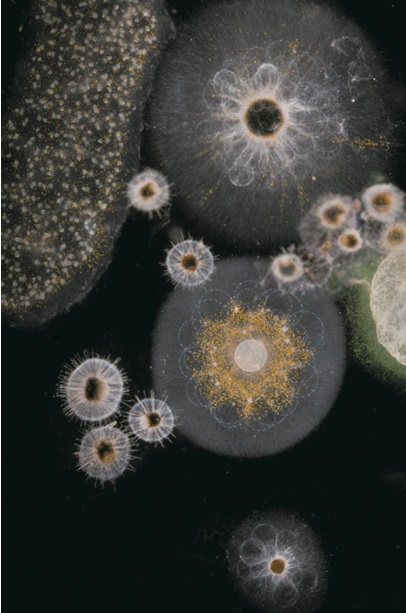Tara Oceans: Exploring the Plankton Forest under the Sea Surface
|
This research topics is based on the studies published in “Science “on May 22, 2015. |
Prof. Ogata, H., Visiting Assoc. Prof. Hingamp, P. (from Left) |
||||||
|
Prof. Ogata, H.1 and Visiting Assoc Prof. Hingamp, P. 1,2 (1Bioinformatics Center, Chemical Life Science Laboratory) (2Information Génomique et Structurale/CNRS, Aix-Marseille University) |
|||||||
|
Plankton support marine life and are essential actors of the planet’s biogeochemical cycles. TheTara Oceans Consortium now released an unprecedentedly large scale dataset on marine plankton after collecting microscopic organisms and physicochemical features across all of the world oceans. The scientists provided new insights into plankton community structures from fish larvae down to the tiny but numerous bacteria and viruses. Hiroyuki Ogata and Pascal Hingamp have taken part since 2009 in this international-multidisciplinary scientific consortium as active coordinating members. |
|||||||
|
By combining the genetic data obtained from the microorganisms (Tara Oceans scientists compiled a new comprehensive catalogue of genetic information composed of 40 million genes from marine organisms. Underlining the necessity of such an endeavour, 80% of these genes were identified for the first time by the Tara Oceans project. Investigating the genetic data from small eukaryotes, the scientists identified an estimated 110,000 eukaryotic planktonic species, which far exceeds the number of species currently described in the literature (11,000 species). |
|||||||
|
Tara Oceans Expedition 2009-2013. Numbers indicate the sampling stations. |
|||||||
|
High performance computing facilities were used to map interactions between plankton species. Interestingly, symbiotic and parasitic relationships were found to be more prevalent than previously thought. Another unexpected finding was that interactions between organisms appeared more crucial than physicochemical conditions in determining the compositions of plankton communities. Hence, as is also the case in our macroscopic terrestrial world, the marine plankton world shapes itself via various interactions among organisms.
Through a topical study around the Cape of Good Hope, it was also found that large mesoscale eddies (called “Agulhas rings”) separate plankton communities between The Indian Ocean and The South Atlantic Ocean. By using the fine grained resolution afforded by high throughput sequencing, this study challenges the hypothesis – based on classical coarse grained fossil morphology data – that global ocean circulation choke points are not barriers to plankton dispersal. |
|||||||
|
Unicellular eukaryotes (radiolarians) |
|||||||
|
A strength of the Tara Oceans approach is that it used highly standardized sampling protocols to collect plankton samples across very different forms of life, from tiny viruses that require an electron microscope to be seen, all the way up to zooplankton, visible to the naked eye. Tara Oceans’ computer analysis pipeline used the KEGG database developed and provided by the group of Minoru Kanehisa at our ICR institute. The data from Tara Oceans are publicly available through several web sites/databases all over the world, including via the GenomeNet Web Services developed at the ICR Bioinformatics Center. These data resources will be used by researchers all over the world in the coming years to further investigate the relationships between the Earth environment and marine ecosystems. |
|||||||
|
Plankton: A diverse group of drifting organisms that live in the water column and that cannot swim against marine currents. In Tara Oceans, researchers analysed plankton corresponding to small viruses (< 0.1 μm), bacteria (0.2-3 μm), protists (1 μm-1 mm) up to zooplankton (several millimeters). Plankton provide 50% of oxygen we breathe, constitute a hidden but large majority of the marine ecosystem, and support life in the oceans as the basis of the food web. However, scientific data and analyses are still limited regarding their diversity, functions and relationships, especially in the context of the ongoing environmental changes.
Tara Oceans Expedition: A global scale plankton sampling campaign carried out by an international and multidisciplinary academic scientific consortium (Tara Oceans Consortium) in collaboration with the privately funded Tara Expéditions Foundation. The consortium is directed by Eric Karsenti (CNRS, France/EMBL, Germany) and Chris Bowler (CNRS/ENS, France), and gathers more than 25 groups of scientists in France, Germany, Spain, Italy, Belgium, USA, UK and Japan. The consortium aims to elucidate the relationship between the Earth environment and oceanic plankton by leveraging the state-of-the-art technologies applied to a 35,000 strong collection of samples collected by the expedition from 2009 to 2013. The results published on 22nd May 2015 were obtained based on a subset of samples collected during the 2009-2012 expedition. |
|||||||
|
A part of the presented work was supported by JSPS KAKENHI (No. 26430184). |
|||||||
|
Related publications (1) Sunagawa, S.; Coelho, L. P.; Chaffron, S., et al., Structure and Function of the Global Ocean Microbiome, Science, DOI: 10.1126/science.1261359. |
|||||||
 Institute for Chemical Research, Kyoto University
Institute for Chemical Research, Kyoto University International Joint Usage Research Center
International Joint Usage Research Center

